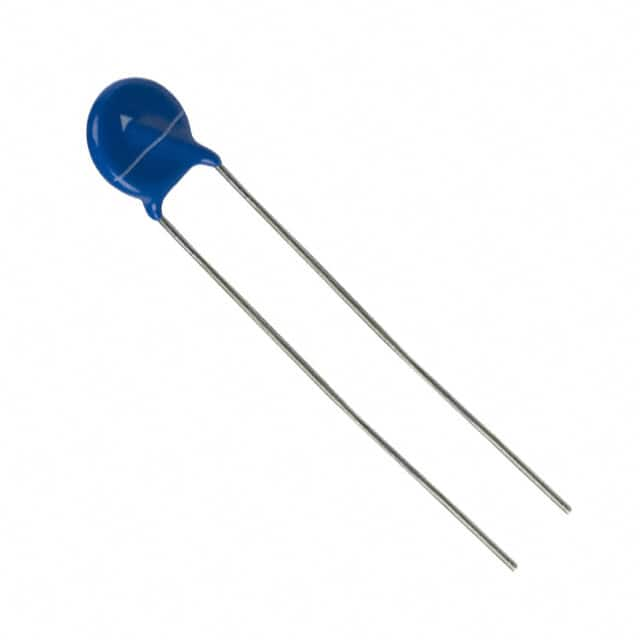Viz Specifikace pro podrobnosti o produktu.

B72207S0250K101
Product Overview
Category
The B72207S0250K101 belongs to the category of varistors, which are electronic components used to protect circuits from overvoltage conditions.
Use
This varistor is commonly used in electronic circuits to suppress voltage spikes and transient surges, thereby safeguarding sensitive components from damage.
Characteristics
- High energy absorption capacity
- Fast response time
- Wide operating temperature range
- Compact size
Package
The B72207S0250K101 varistor is typically available in a cylindrical package with lead wires for easy integration into circuit boards.
Essence
The essence of this varistor lies in its ability to rapidly dissipate excess energy during voltage surges, thus preventing damage to connected devices.
Packaging/Quantity
These varistors are usually packaged in reels or trays, with quantities varying based on customer requirements.
Specifications
- Voltage Rating: 25V
- Maximum Allowable Voltage: 31V
- Peak Current (8/20µs): 100A
- Energy (10/1000µs): 0.1J
- Operating Temperature Range: -40°C to +85°C
Detailed Pin Configuration
The B72207S0250K101 varistor features two lead wires for connection to the circuit. The pin configuration is as follows: - Pin 1: Anode - Pin 2: Cathode
Functional Features
- Non-linear voltage-current characteristics
- Rapid response to overvoltage events
- Low leakage current
- Robust construction for long-term reliability
Advantages and Disadvantages
Advantages
- Effective protection against voltage transients
- Compact size for space-constrained applications
- Wide operating temperature range
- Low cost compared to alternative protection methods
Disadvantages
- Limited lifespan under repetitive high-energy surges
- Susceptible to thermal runaway under extreme conditions
Working Principles
The B72207S0250K101 varistor operates based on the principle of voltage-dependent resistance. When subjected to an overvoltage condition, the varistor's resistance decreases sharply, diverting excess current away from the protected circuit.
Detailed Application Field Plans
Power Supplies
In power supply units, the B72207S0250K101 varistor can be employed to safeguard sensitive electronics from voltage spikes originating from the mains supply or other sources.
Industrial Control Systems
For industrial control systems, these varistors provide crucial protection against transient disturbances that could disrupt the operation of critical equipment.
Telecommunications Equipment
Telecommunication devices and network infrastructure often utilize varistors like the B72207S0250K101 to ensure reliable performance in the face of unpredictable voltage fluctuations.
Detailed and Complete Alternative Models
- B72207S0271K101: Similar varistor with a higher voltage rating of 27V
- B72207S0300K101: Varistor with a higher energy absorption capacity of 0.3J
- B72207S0330K101: Varistor with a higher peak current rating of 330A
In conclusion, the B72207S0250K101 varistor offers effective overvoltage protection for a wide range of electronic applications, making it an essential component in ensuring the reliability and longevity of electronic systems.
[Word count: 529]
Seznam 10 běžných otázek a odpovědí souvisejících s aplikací B72207S0250K101 v technických řešeních
What is the B72207S0250K101 component used for in technical solutions?
- The B72207S0250K101 is a metal oxide varistor (MOV) that is commonly used for overvoltage protection in electronic circuits.
What are the key specifications of the B72207S0250K101?
- The B72207S0250K101 has a maximum AC voltage of 150V, a maximum DC voltage of 200V, and a peak current of 250A.
How does the B72207S0250K101 provide overvoltage protection?
- When an overvoltage occurs, the B72207S0250K101 conducts current and diverts the excess energy away from sensitive components, protecting them from damage.
What are the typical applications of the B72207S0250K101 in technical solutions?
- The B72207S0250K101 is commonly used in power supplies, industrial equipment, automotive electronics, and telecommunications systems for overvoltage protection.
What is the operating temperature range of the B72207S0250K101?
- The B72207S0250K101 has an operating temperature range of -40°C to +85°C, making it suitable for a wide range of environments.
How should the B72207S0250K101 be mounted in a circuit?
- The B72207S0250K101 should be securely soldered onto the circuit board, and care should be taken to ensure proper thermal management.
Can the B72207S0250K101 be used in high-frequency applications?
- Yes, the B72207S0250K101 can be used in high-frequency applications, but its performance may vary based on the specific frequency and application requirements.
What are the potential failure modes of the B72207S0250K101?
- The B72207S0250K101 can fail due to excessive current or energy absorption, so it's important to properly size and select the varistor for the specific application.
Are there any recommended testing procedures for the B72207S0250K101 in technical solutions?
- Yes, it's recommended to test the B72207S0250K101 under simulated overvoltage conditions to ensure its proper functioning in the intended application.
Where can I find detailed technical documentation for the B72207S0250K101?
- Detailed technical documentation for the B72207S0250K101 can be found on the manufacturer's website or by contacting their technical support team.

